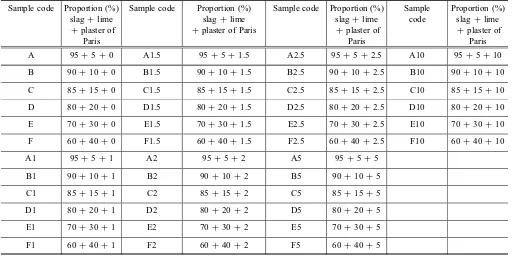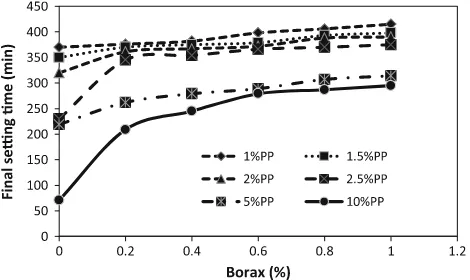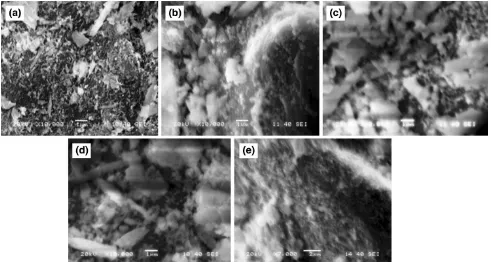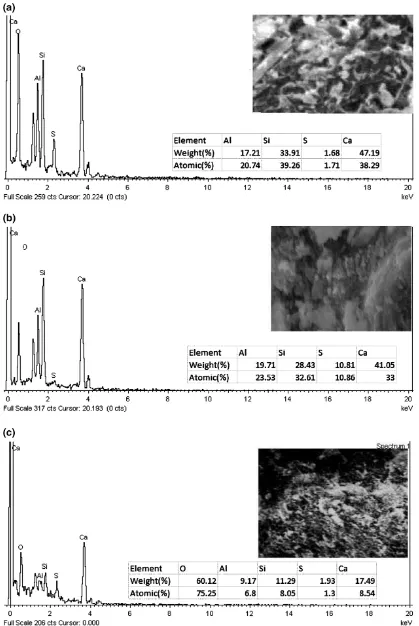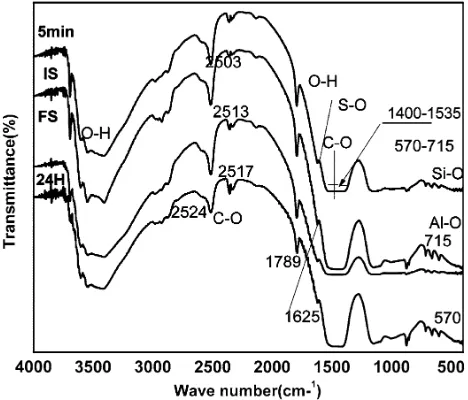Hydration Products, Morphology and Microstructure of Activated Slag
Cement
Meena Murmu, and Suresh Prasad Singh*
(Received May 4, 2013, Accepted September 3, 2013)
Abstract: This paper reports the physical properties and hydration products of slag cement that was prepared by activating ground granulated blast furnace slag with commercial lime and plaster of Paris (POP) as activators. The consistency, setting times and soundness of various mixes of slag-lime-POP is reported. The hydration products and formation of bonds in the paste during setting were studied with the help of SEM, FTIR and XRD tests and the same are correlated to the hydration process. The setting times of the mixes are found to be lower than that of the value prescribed for ordinary Portland cement (OPC). Borax is used as a setting retarder and a borax content of 0.4 % by mass gives setting times that are normally prescribed for OPC. In the early stages of setting C–A–S–H gels are found in this cementing material instead of C–S–H gel, as generally observed in the OPC.
Keywords:ground granulated blast furnace slag, consistency, setting time, soundness, hydration products.
1. Introduction
Activated slag cement (ASC) is an attractive alternative to Portland cement. Activated slag cement is a mixture of poz-zolana and activator. The activation of slag is normally achieved by mixing it with either compounds of alkalis or alkaline earth materials. The calcination is not required in the manufacturing process, thus burning of fossil fuel is avoided. These new cementing materials are characterized by their nearly equal mechanical strengths, and also they don’t require high energy in their manufacturing process. Depending on the nature of raw materials to be activated and type of activators used, different reactions developed, which have different physical and mechanical properties and microstructures.
A good number of literatures are available on activated slag cement. These works mainly focus on mechanical strength properties of ASC. However, the available work on the physical properties of slag activated with alkalis and alkaline earth compounds are rather limited. The setting characteristics of slag-lime mixes were studied by Feret (1939) and Jolibois and Nicol (1952) by using granulated slag and high calcium lime. The slow setting of the mixes was improved by adding sodium sulfate to the extent of 1 %, but it suffered from producing efflorescence. An addition of gypsum is recommended in their work instead of sodium sulfate. Mehrotra et al. (1982) opined that plaster of Paris is a better activator than the conventional hard burnt gypsum
(anhydrite) but, this cement has shorter setting time. Naceri et al. (2009) activated the slag cement by hydrated lime with 0, 2, 4, 6, 8 and 10 % (by addition and substitution method) and observed a decline of setting time with increase of lime content. Bijen and Niel (1981) and Dutta and Borthakur (1990) reported the physical properties of super sulphated slag cement prepared by using slag, anhydrite/gypsum and clinker. The optimum amount of anhydrite to activate the slag was reported to vary between 15 and 20 %. Wang et al. (1995) reported that the slag activated with sodium hydroxide poses quick setting and high shrinkage with micro crack formation. Brough et al. (2000) used phosphate and malic acid as retarders in slag and sodium silicate base mixes to increase the setting time of the alkali activated slag cement. Glukhovsky et al. (1983) and Talling and Brandstetr (1989); (Puertas and Fernandez-Jimenez2003) and Shi and Li (1989) have studied extensively the alkaline activation of slag and the hydration products. The main hydration product is reported to be hydrated calcium–alumina–silicate, like C–A–S–H gel. This phase is different from that formed in the Portland cement in the early period of hydration and has a lower C/S ratio. Gong and Yang (2000) studied the effect of phosphate on the hydration of alkali activated red mud slag through micro calorimeter, X-ray diffraction and energy dispersive spectroscopy. The setting time was found to be retarded due to the production of a new phase of (CaNa) O(SiAl) O2y (CaNa) SO4xH2O. Kim and Hong (2001)
observed that the ion concentration change of liquid phase during hydration was different depending on the activator and the hydration time.
This work aimed at to identify the hydration products and chemical bonds that develop in the early stages of setting and hardening in the lime activated slag cement. This also examines the morphology and microstructure of cement National Institute of Technology Rourkela, Rourkela,
Odisha, India.
*Corresponding Author; E-mail: spsingh@nitrkl.ac.in CopyrightÓThe Author(s) 2013. This article is published with open access at Springerlink.com
International Journal of Concrete Structures and Materials Vol.8, No.1, pp.61–68, March 2014
paste during setting and hardening process and to understand the mechanism of strength gain in the mortar sample.
2. Experimental Details
2.1 Materials
The blast furnace slag used in this work was collected from Rourkela steel plant (RSP). The slag was sun dried and mixed thoroughly to bring homogeneity in the sample. The same was ground in a ball mill to Blaine’s fineness value of 410 m2kg-1. The plaster of Paris and hydrated lime used were procured from the local market. The chemical compositions of the slag, lime and plaster of Paris were determined from EDX tests, and the same is shown in Table1.
2.2 Methodology
2.2.1 Physical Properties
The physical properties such as consistency, initial setting time (IS), final setting time (FS) and soundness of the mixes,
containing different raw materials proportions, were deter-mined. The raw material proportions of trial mixes are given in Table2. The consistency, initial and final setting times of mixes was determined as per (IS 4031 -1988 part 4 & 5) respectively using Vicat’s apparatus. Borax is used as a retarder of setting time. The amount of borax was varied as 0.0, 0.2, 0.4, 0.6, 0.8 and 1 % of the total dry mass of the mix. The excess of free lime and magnesia present in the binder was determined conducting soundness tests, con-forming to IS 4031–1988 (part-3). Le-Chatelier’s soundness apparatus was used for this purpose.
2.2.2 Chemical Bonds and Hydration Products The hydration products and formation of bonds in the paste were studied using several techniques like SEM, FTIR and XRD tests. Microscopic studies were undertaken to examine the morphology and microstructure of hydrated specimens. These were done by a JEOL 6480 LV SEM, equipped with an energy dispersive X-ray detector of the Oxford data reference system. The powdered sample was loaded and fixed in the sample holder using a carbon tape
Table 1 Chemical composition of raw materials (wt%).
Composition Slag Plaster of Paris Lime Composition Slag Plaster of Paris Lime
MgO 9.52 1.92 2.47 Fe2O3 1.37 0.852 0.381
Al2O3 21.86 1.13 0.68 Na2O 0.088 1.55 1.54
SiO2 30.82 0.916 2.75 MnO 0.14 – –
K2O 1.04 0.661 0.9 TiO2 1.04 – –
P2O5 – 0.58 – SO3 0.66 39.88 –
CaO 32.42 41.45 90.26 Loss on Ignition 1.0 6.25 0.84
Table 2 Details mix proportions of raw materials.
Sample code Proportion (%) slag?lime ?plaster of
Paris
Sample code Proportion (%) slag?lime ?plaster of Paris
Sample code Proportion (%) slag?lime
?plaster of Paris
Sample code
Proportion (%) slag?lime
?plaster of Paris
A 95?5?0 A1.5 95?5?1.5 A2.5 95?5?2.5 A10 95?5?10
B 90?10?0 B1.5 90?10?1.5 B2.5 90?10?2.5 B10 90?10?10
C 85?15?0 C1.5 85?15?1.5 C2.5 85?15?2.5 C10 85?15?10
D 80?20?0 D1.5 80?20?1.5 D2.5 80?20?2.5 D10 80?20?10
E 70?30?0 E1.5 70?30?1.5 E2.5 70?30?2.5 E10 70?30?10
F 60?40?0 F1.5 60?40?1.5 F2.5 60?40?2.5 F10 60?40?10
A1 95?5?1 A2 95?5?2 A5 95?5?5
B1 90?10?1 B2 90?10?2 B5 90?10?5
C1 85?15?1 C2 85?15?2 C5 85?15?5
D1 80?20?1 D2 80?20?2 D5 80?20?5
E1 70?30?1 E2 70?30?2 E5 70?30?5
F1 60?40?1 F2 60?40?2 F5 60?40?5
which is further coated with a thin layer of electrically conductive platinum material. Micrographs were taken at accelerating voltages of 20 kV for the best possible resolu-tion from the surface. The XRD tests were used to determine the phases that appeared in the pastes. This was performed by using Philips X’ PERT System X-Ray Diffractometer. The powder sample was affixed to the sample holder and the upper surface of the sample was smeared by a glass slide to get a smooth and uniform surface. The specimen was then placed in the diffractometer and scanned in a continuous mode from 7°to 70°with a scanning rate of 0.05°s-1. The formation of different bonds during the hydration process was studied in Fourier Transform Infrared (Perkin Elmer, USA/RX-I FTIR-TM series) equipment. After a specified period of setting/hydration representative samples were collected and soaked in anhydrous ethanol to stop further hydration. These samples were ground to sizes less than 75lm before being used in SEM, XRD and FTIR tests. Further, the specimens used in FTIR tests were prepared by mixing 1 mg of the powdered sample in 300 mg of KBr. The spectral analysis was performed in the range 4,000–400 cm-1with spectral resolution of 1 cm-1.
3. Results and Discussion
3.1 Consistency
The variation of normal consistency values with lime at a given plaster of Paris content is presented in Fig.1. It is seen
Fig. 1 Variation of consistency values with lime content.
Fig. 2 Variation initial setting time with lime content.
Fig. 3 Variation final setting time with lime content.
Fig. 4 Effect of borax on initial setting time at 20 % lime content.
Fig. 5 Effect of borax on final setting time at 20 % lime content.
that the normal consistency increases with either increase in lime or plaster of Paris contents. The consistency values of slag-lime-plaster of Paris mixes vary over a wide range from 28.89 to 37.7 % compared to the value of about 30 % for ordinary Portland cement (OPC). The increase of water demand or consistency mainly depends on percentage of lime and plaster of Paris content in the mix. This is attributed to the increase of calcium ions in the mixture or increase of (Ca/Si) ratio. Hence an increase in lime and/or plaster of Paris content in the mixture results in an increase in con-sistency values. A similar trend was also observed by Benghazi et al. (2009).
3.2 Setting Time
The effects of lime on initial and final setting times of slag-plaster of Paris mixes are delineated in Figs.2 and 3 respectively. The setting time of mixes containing no plaster of Paris is too long for cementing materials, as prescribed in Bureau of Indian Standards. A marginal decrease in both initial and final setting times is observed with the increase in lime contents. Similar results were also obtained by Naceri et al. (2011). The reduction in setting time of the mix in addition of lime is due to increase in cation concentration and increase in pH value of the mix. In alkaline activation, the introduction of calcium hydroxide, sodium hydroxide, soda and others in an aqueous solution leads to formation of corresponding silica-hydrate. The calcium silicate is known to be structure forming phase whereas the sodium silicate is soluble. This results in a marginal decrease in setting of the mix. Further, it is observed that at a given lime content, an increase in plaster of Paris greatly reduces the setting time. This quick setting action is attributed to the high concen-tration of sulfate ions in solution, which reacts quickly with aluminum rich slag forming hydrated products. It is reported by Chandra (1996) that when the calcium sulfate activator is mixed with slag, it interacts directly with the alumina, cal-cium hydroxide and water to form hydro-sulfate-aluminates 3CaO–Al2O3–CaSO4–12H2O along with other new
phase-formations during the hardening process. This results in a decline in setting times of the mix. In general, it is observed that the initial and final setting times of the mixes containing plaster of Paris are lesser than that of the value prescribed for ordinary Portland cement. In order to ward off or overcome this problem borax was added in these mixes. The effect of borax on the initial and final setting times of slag-plaster of
Fig. 7 XRD patterns of hydrated specimens after setting periods of 5 min; initial setting time (IS); final setting time (FS); 2 h and 24 h.
Paris mixes at 20 % lime content is highlighted in Figs.4and5respectively. From these figures, it is observed that the setting times increased when the borax is added to a mixture of slag-lime-plaster of Paris. Further, it is observed
that the retarding effect is not significant before a critical amount of retarder was used; beyond this the setting time increases. This indicates the retarding effect is very sensitive to the amount of retarder. Excess amount borax retards the
setting time too much. On the other hand, insufficient amount of retarder cannot retard the setting time to the required workability. Similar results were also obtained by Mehrotra et al. (1982) and Chang (2003). It is well known that the anions and cations present in the activators play a major role in deciding the physical properties of fresh mix-tures. The setting times mainly depend on activator type and concentration of the activator. It is found that a borax content of 0.4 % is sufficient to increase the initial setting time from 11 min to a workable range of 23 min and final setting time from 72 to 245 min. Higher borax contents further delay the initial setting than that prescribed for OPC.
3.3 Soundness
The soundness value of various mixes of slag-lime-plaster of Paris is presented in Fig.6. It is seen that the soundness of these mixes varies between 1 and 2.5 mm for all mixes except for the mix containing 10 % plaster of Paris and 40 % lime. For the said composition, the soundness value is 3 mm. It may be due to the presence of an excess amount of free calcium and magnesia in the mix. According to Bureau of Indian Standards, the soundness of cement shouldn’t exceed 10 mm. Therefore, the above mixes are sound and can be used as building material.
3.4 Chemical Bonds and Hydration Products The formation of chemical bonds was studied by using FTIR. The microstructure and hydration products during setting or hydration process were examined using SEM and XRD analysis. The hydrated paste containing 80 % slag, 20 % lime and 10 % plaster of Paris was analyzed by XRD (with the testing condition: CuKa; 7°–70°; 2h; 2°min-1) after different set periods. The XRD patterns of specimens cured for different setting periods are shown in Fig.7. From X-ray diffraction analysis, a series of crystalline compounds such as calcium hydroxide, quartz, calcium–sulfate–hydrate, portlandite, calcium silicate hydrate and gypsum was found. As hydration time increased the series of crystalline com-pounds or phases are intensified. The crystalline peaks of calcium–sulfate–hydrate, calcium carbonate and portlandite appeared at 5 min. Thereafter, that is at 11 min (initial set-ting time) quartz and gypsum compounds appeared, and the peaks become more intensified. An increase in the hydration period, especially at 72 min (final setting time) the peaks become more intensified. However, the peaks after 24 h of setting and abundance of calcium–silicate–hydrate are observed. The microstructure, surface morphology and hydration products of specimens cured for different periods are studied using SEM and EDX analyzer respectively. Figure8shows the surface morphology of specimens cured for different periods. Abundance of needle-like structures is found in specimens cured for 5 min. Usually needle-like crystals appeared during the early period of hydration. As curing period proceeds in, the needle-shaped crystals change to hexagonal platy crystals and some gel-like substances appeared. Further increase in setting period (24 h of curing) results in an increase of crystal concentration and more gel like phase of calcium–alumina–silicate–hydrate appeared.
This results in an increase of strength and hardness of specimens. The elemental composition was analyzed using EDX. The EDX output for D10 sample after the curing period of 5, 11 min and 24 h are shown in Fig.9a, b, c respectively along with the corresponding surface mor-phology obtained from SEM analysis. At early stage of setting (Fig.9a) hydrated oxides of Ca, Al, S, and Si are found indicating the presence of compounds of calcium– alumina–sulfate–hydrate that is the C–A–S–H gel. At 11 min (Fig.9b) abundance of element sulfur is noticed in addition to other elements like Ca, Al and Si, indicating intensification of calcium–alumina–sulfate–hydrate com-pounds. The C–A–S–H gel is found to form in the early stages of curing in alkali activated slag cement instead of C–S–H gel, as generally found in hydration-products of OPC. A similar observation was also reported by Puertas et al. (2011). Specimen cured for a longer period that is 24 h of curing (Fig.9c) showed presences of Ca, Al, Si and S indicating the formation of both calcium–alumina–sulfate– hydrate and calcium–silicate–hydrate compounds. At this setting time the atomic percentage of sulfur is much lower than the earlier cases. This may be due to conversion of tri-sulfate alumina (AFt) to mono-tri-sulfate alumina (AFm). The Si/Ca (% atomic ratio) is 1.02, 0.98 and 0.94 at 5, 11 min and 24 h setting of the sample respectively. From this it is concluded that more amount of calcium reacted with un-reacted silicon ion of slag. The Al/Ca (% atomic ratio) is 0.54, 0.71, and 0.79 at 5, 11 min and 24 h setting of the sample respectively and in all the cases the concentration of Al is lower as compared to Si. These parameters indicate the formation of C–S–H phase with an increase in curing period. The presence of this phase results in imparting hardness and strength to the mass. The elemental analyses of samples, cured for different periods, show compounds that are iden-tified earlier from XRD analysis. Hence, the EDX analysis confirms the XRD results. The FTIR spectra of the D10 specimen are given in Fig.10 for different curing periods.
Analysis of the results showed the bands of O–H at wave numbers 1,780 and 3,345–3,500 respectively. The minor band range 570–715 cm-1 indicate presences of small amounts of siliceous and alumina-silicate material. The stretching vibration band of O–H is banded at wave number of 3,345–3,500 cm-1due to calcium hydroxide phase. The presences of peak at 1,410 cm-1 is due to the bonding in CO32- ions. This indicates the presence of carbonated
minerals, possibly due to the absorption of CO2 from the
atmosphere. The bending vibration band of O–H is observed at wave numbers 875 cm-1. The quick setting of paste is due to S-rich compounds such as gypsum. Prominent peaks found at 1,650 cm-1indicates the formation of S–O bonds in the paste. The presences of this bond indicated the for-mation of calcium–sulfate–hydrate phase. The S–O and O–H groups are found to be shifted right with the increase in curing period. This indicates that the hydration process continues with setting time and more amount of calcium– sulfate–hydrate gel is formed during the hydration process.
4. Conclusions
The physical properties of GGBFS activated with com-mercial lime and plaster of Paris were studied in this work. Based on the experimental findings, the following conclu-sions are drawn:
– The normal consistency values of slag-lime-plaster of Paris mix increase with either increase in lime or plaster of Paris content. The consistency values for the present raw material compositions vary over a wide range from 28.8 to 37.7 % as compared to about 30 % of ordinary Portland cement (OPC).
– The initial and final setting times of the mixes decrease with either increase in lime and/or plaster of Paris content. In general, the initial and final setting times of the mixes are lesser than that of the value prescribed for ordinary Portland cement. An addition of borax retards the setting time and a borax content of 0.4 % by mass gives the setting time that is normally prescribed for OPC.
– The soundness of this binder varies between 1 and 3 mm, which is lower than that of the value prescribed for ordinary Portland cement by Bureau of Indian Standards.
– X-ray diffraction analysis shows a series of crystalline compounds such as calcium–sulfate–hydrate, portlan-dite, calcium–silicate–hydrate and calcite.
– SEM analysis also confirms the existence of these compo-nents in the hydrated specimens as calcium–sulfate–hydrate gel and calcium–alumina–iron oxides. In the early stages of setting C–A–S–H gels are found in this cementing material instead of only C–S–H gel, as normally found in hydration products of OPC. However, after 24 h of setting both C–S–H and C–A–S–H phases are found.
– FTIR analysis shows a shift of S–O and O–H bands with wave number, indicating that the hydration process continues with setting time and confirms the formation of calcium–sulfate–hydrate gel during the reaction.
– The increase in stiffness of the pastes during setting is due to the intensification of crystalline compounds such as calcium hydroxide, calcium–sulfate–hydrate, portlandite, gypsum and calcium–silicate–hydrate with setting period.
Open Access
This article is distributed under the terms of the Creative Commons Attribution License which permits any use, distribution, and reproduction in any medium, provided the original author(s) and the source are credited.
References
Benghazi, Z., Zeghichi, L., & Hamdane, A. (2009). Study of alkali activated pozzolana/slag cement. 1st International conference on Sustainable Built Environment Infrastructures in Developing Countries, ENSET Oran (Algeria), 335–342. Bijen, J., & Niel, E. (1981). Super sulphated cement from blast furnace slag and chemical gypsum available in the Ne-therland and neighboring countries. Cement Concrete Research, 11(3), 307–322.
Brough, A. R., Holloway, M., Sykes, J., & Atkinson, A. (2000). Sodium silicate based alkali-activator slag mortars: Part II the retarding effect of additions of sodium chloride or malic acid.Cement Concrete Research, 30(9), 1375–1379. Chandra, S. (1996). Waste materials used in concrete
manu-facturing(pp. 235–282). Westwood, NJ: William Andrew. Chang, J. J. (2003). A study on the setting characteristics of sodium silicate-activated slag pastes. Cement Concrete Research, 33, 1005–1011.
Dutta, D. K., & Borthakur, P. C. (1990). Activation of low lime high alumina granulated blast furnace slag by anhydrite. Cement Concrete Research, 20(5), 711–722.
Feret, R. (1939). Revuedes Materiaux de construction et des. Travaux Publics, 355, 61.
Glukhovsky, V. D., Zaitsev, Y., & Pakhomow, V. (1983). Slag-alkaline cements and concrete structures, properties, tech-nological and economic aspects of the use. SilicInd, 10, 197–200.
Gong, C., & Yang, N. (2000). Effect of phosphate on the hydration of alkali activated red-mud slag cementious materials.Cement Concrete Research, 30(7), 1013–1016. IS: 4031–1988 (PT 4). Method of physical test for hydraulic
cement: Part 4 Determination of standard consistency of cement paste, Bureau of Indian Standards, New Delhi, India, 1988.
IS: 4031–1988 (PT 5). Method of physical test for hydraulic cement: Part 5 Determination of initial and final setting time,Bureau of Indian Standards, New Delhi, India, 1988. IS: 4031–1988 (PT 3). Method of physical test for hydraulic cement: Part 3 Determination of soundness, Bureau of Indian Standards, New Delhi, India, 1988.
Kim, J. C., & Hong, S. Y. (2001). Liquid concentration changes during slag cement hydration by alkali activation.Cement Concrete Research, 31(2), 283–285.
Mehrotra, V. P., Sai, A. S. R., & Kapur, P. C. (1982). Plaster of Paris activated super sulfated slag cement. Cement and Concrete Research, 12(4), 463–473.
Naceri, A., Bouglada, M. S., & Belouar, A. (2011). Activation of slag cement by hydrated lime. Applied Mechanics and Material, 71–78, 706–711.
Naceri, A., Bouglada, M. S., & Grosseau, P. (2009). Mineral activator and physical characteristics of slag cement at anhydrous and hydrated states.World Academy of Science, Engineering and Technology, 32, 137–139.
Puertas, F., & Fernandez-Jimenez, A. (2003). Mineralogical and microstructure characterization of alkali-activated fly ash/ slag pastes.Cement Concrete Composites, 25(3), 287–293.
Puertas, F., Palacios, M., Manzano, H., Dolado, J. S., Rico, A., & Rodrı´guez, J. (2011). A model for the C–A–S–H gel formed in alkali-activated slag cements. Journal of the European Ceramic Society, 31(12), 2043–2056.
Shi, C., & Li, Y. (1989). Investigation on some factors affecting the characteristics of alkali-phosphorus slag.Cement Con-crete Research, 19(4), 527–533.
Talling, B., & Brandstetr, J. (1989). Present state and future of alkali–activated slag concretes fly ash, silica fume, slag, and natural pozzolans in concrete. In Proceedings 3rd International Conference Trondheim, Norway, SP114-74, 1519–1545.
